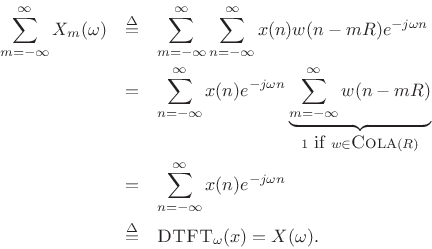Mathematical Definition of the STFT
The usual mathematical definition of the STFT is
[9]
where

If the window ![]() has the
Constant OverLap-Add (COLA) property at hop-size
has the
Constant OverLap-Add (COLA) property at hop-size ![]() , i.e., if
, i.e., if
then the sum of the successive DTFTs over time equals the DTFT of the whole signal

We will say that windows satisfying
![]() (or some
constant) for all
(or some
constant) for all
![]() are said to be
are said to be
![]() . For example,
the length
. For example,
the length ![]() rectangular window is clearly
rectangular window is clearly
![]() (no overlap).
The Bartlett window and all windows in the generalized Hamming family
(Chapter 3) are
(no overlap).
The Bartlett window and all windows in the generalized Hamming family
(Chapter 3) are
![]() (50% overlap),
when the endpoints are handled correctly.8.1 A
(50% overlap),
when the endpoints are handled correctly.8.1 A
![]() example
is depicted in
Fig.8.9. Any window that is
example
is depicted in
Fig.8.9. Any window that is
![]() is also
is also
![]() ,
for
,
for
![]() , provided
, provided ![]() is an
integer.8.2 We will explore COLA windows
more completely in Chapter 8.
is an
integer.8.2 We will explore COLA windows
more completely in Chapter 8.
When using the short-time Fourier transform for signal processing, as taken up in Chapter 8, the COLA requirement is important for avoiding artifacts. For usage as a spectrum analyzer for measurement and display, the COLA requirement can often be relaxed, as doing so only means we are not weighting all information equally in our analysis. Nothing disastrous happens, for example, if we use 50% overlap with the Blackman window in a short-time spectrum analysis over time--the results look fine; however, in such a case, data falling near the edges of the window will have a slightly muted impact on the results relative to data falling near the window center, because the Blackman window is not COLA at 50% overlap.
Next Section:
Practical Computation of the STFT
Previous Section:
Example: Pink Noise Analysis






















